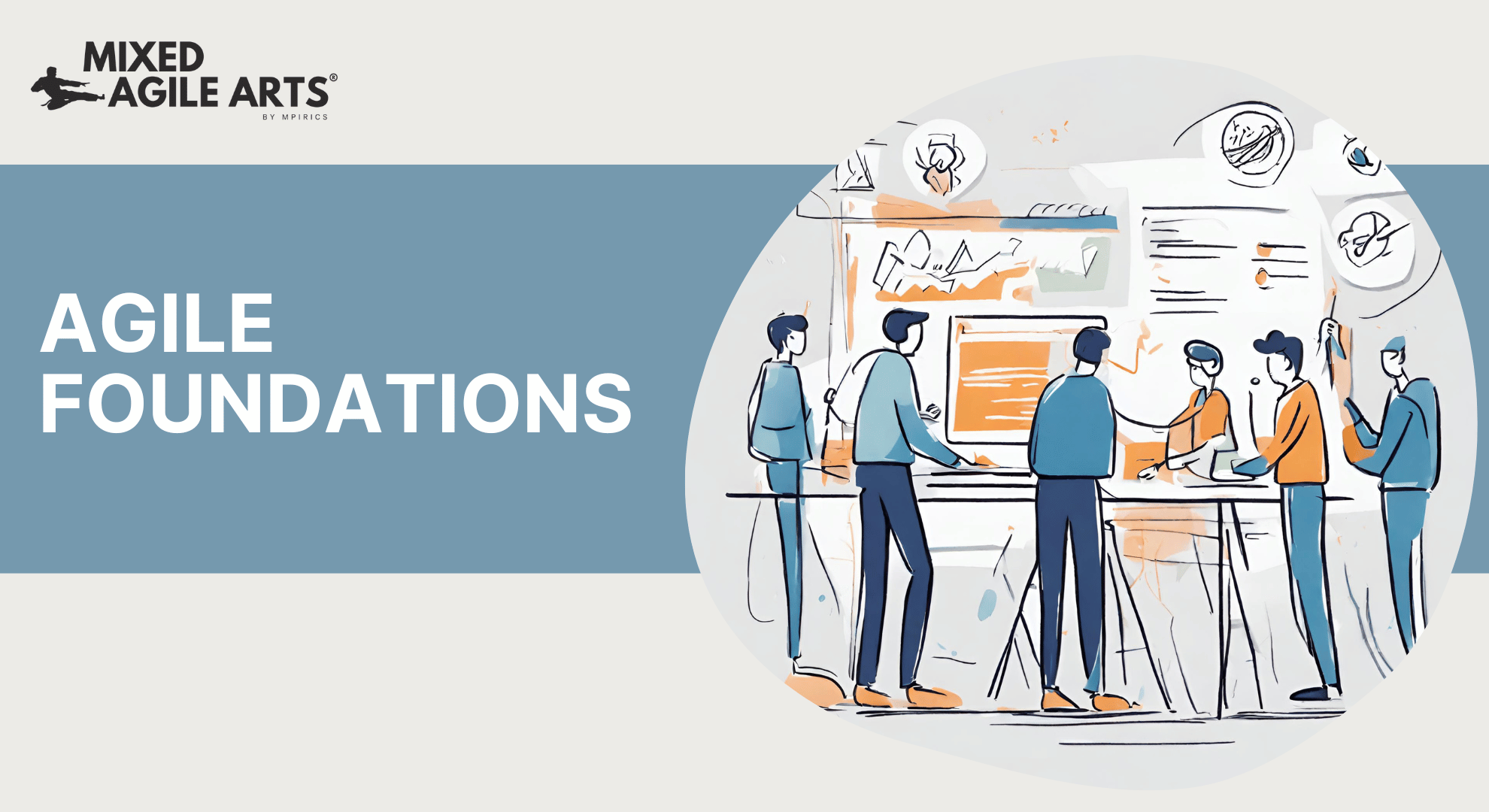Agile Foundations
Learn to understand the difference between “Doing Agile” and “Being Agile” and how to apply agile principles and values in your daily work!
Diving instead of snorkeling
Go diving with us on the “reef of agility” and discover the true agile world! What does it mean to be truly agile? Where does “agile” come from and why is it more important than ever to work agile today? Where does agility make sense? What agile methods and frameworks are there?
What our participants say
4.9

The training helped me to really understand agility. For us, it was previously seen as "just another process" - and only for developers.

The deep dives have opened my eyes! I now understand what is important. It makes total sense, but "Being Agile" is still so far away ...

It made so much sense to look at the agile principles again in this level of detail and depth. And for years I thought I knew what Agile was.

The Cynefin Framwork and the Stacey Matrix make it completely clear where and why Agile makes sense! Your "I know it, when I see it" (IKIWISI) clicked with me!

After the training ...
- you have a deep understanding of complex domains
- you do understand where Agile comes from and why it came about
- you know where to focus your attention
- you can translate the agile principles into your everyday life
- you understand "Doing Agile" as the first step towards "Being Agile"
- you understand agility as an instrument of cultural change
- you know the most important representatives of agile frameworks and methods
You will leave this training with a new mindset and many ideas on how to make the principles your own! Based on a deep understanding of agility, you can clearly identify which behaviors and mindsets need to be changed.
Online
Learn when you want and where you want! The training is modular and you can consume it from anywhere. All you need is a computer with Internet access.
Self-paced
Do your training at your own pace! Speed and pauses to your liking; reflect on what you have learned whenever you feel it is right and necessary.
Community powered
And you have a community of like-minded learners, trainers and coaches at your side to support and motivate you on your learning journey.
What you will learn
- Understanding complexity - the Cynefin Framework
- Empirical vs. defined processes and navigation in the VUCA world
- Background to the Agile Manifesto and how it should be understood today
- Delivering value early and often, emergence and empiricism
- Changeability and technical debt
- Simplicity, Done, continuous improvement
- Motivation, collaboration and communication
- Sustainable progress: input, output & outcome, push vs. pull
- Iterative, incremental development
- Overview of agile methods and frameworks
We will not leave you alone!
Ask the community
In the Mixed Agile Arts® Community you will get answers to your questions, practical examples and much more during and after the training.
Become a Pro member
Choose the Pro membership to receive many regular events, mentoring from our trainers and exchange with like-minded people. There are also plenty of other online courses available to you.
The contents in detail
Module 1
Understanding complexity
Use the Cynefin framework to learn about the different contexts of our working environments and where agility makes sense. What is special about complex contexts and where and why do traditional working methods reach their limits?
Module 2
The Agile Manifesto
The “Manifesto for Agile Software Development” has unleashed a movement that goes far beyond software today. Get to know the background and understand it in the context of today’s uncertain, complex and volatile world.
Module 3
Deliver value early and frequent
In this deep dive, we discuss this first and most important agile principle. Learn why it is so important to satisfy customers by delivering value early and how this principle is at the center of the agile universe.
Module 4
Changeability, Simplicity, Technical debt & Done
In this module, we take two deep dives and discuss why it is difficult – but also so important – to master technical practices or “crafmanship” and with which mindset we approach our work.
Module 5
Motivation, Collaboration & Communication
Learn which ideas are used to promote collaboration in agile teams and which framing conditions need to be created so that we can achieve extraordinary success from the motivation of committed people.
Module 6
Sustainable progress
How do agile teams manage to deliver sustainably and reliably? What influence does progress measurement and estimation have on this? What is the difference between input and output measurement? What influence does push vs. pull have on delivery capability and sustainability?
Module 7
Emergence & empirical approach
High frequent feedback loops are a pivotal component of all agile approaches. Learn how these can be effectively integrated into the day-to-day work of agile teams and what is possible when installing them. How can you integrate new knowledge and insights and live agility properly?
Module 8
The agile mindset
In this module, after all the “deep dives”, we take the other direction and zoom out: We look at the big picture to see what’s the difference between doing agile and being agile and whcih steps are necessary to become a truly agile organization.
Module 9
Frameworks and methods
Finally, we look at a selection of agile frameworks and methods: Which ones existed and which are still relevant today? How do they differ from each other and where are they similar? How can agile ideas be transferred to greater economies of scale (“scaling”) and where should you start?
What makes our training so special?
Practical, experienced and professional
This training has been put together by certified trainers with practical experience since the early days of agility. We have been among the pioneers since the 90s! Many of these learning contents are modules from the certification training courses (CSM, CSPO, CSD, CAL) and form a basis for this. You get practical experience here, not book knowledge!
Examples from daily practice
Our training content is based on real examples from the daily practice of agile teams under real conditions.
Experts in agility, experts in learning
Because it does matter who you learn from, we have always acquired expertise in human learning.
Much more than just training
In line with our motto "From knowledge to competence", we won't leave you alone on your journey: with support from our community, this is where it all begins.

Any questions?
FAQ
If you cannot find an answer in our FAQs, we will be happy to help you. Simply book an appointment with us!
Who is the Agile Foundations Training for?
This training is aimed at all people who want to understand the topic of “agility” fundamentally and, above all, correctly. Time and again, we meet people who have a partially false image and distorted ideas of agility – this often leads to lip service and “agile transformations” that only have an outward appearance.
If you intend to anchor agility in your team or organization in a sustainable and effective way, this training will lay the foundation for your further journey.
Do I have to fulfill any requirements?
No. You can complete this training without any prior knowledge.
What are the technical requirements for the training?
You need a computer with a modern Internet browser (Chrome, Safari, Firefox or Edge – always the latest version) or a tablet with the latest version of iOS or Android. The device must be able to play audio and video. So if you can watch YouTube videos with it, it should work 😉
In addition, you need an Internet connection with halfway decent speed (in the sense of the above). So you have to be online to consume the content.
Can I do the training without being connected to software?
Yes, absolutely. Although agility in the sense discussed here originates from software development, it has many roots in “lean” and the ideas are generally applicable to all kinds of knowledge work.
We discuss agility, values and principles from the origins of software development though, but we always try to establish a general context. The differentiation in Module 1 is particularly helpful in understanding where agile approaches can be applied today.
However, there are areas where agility makes less sense, for example in production, where it would be a “detour”, because the roots were created over 50 years ago by Toyota with Lean. In short, when we talk about knowledge work or tasks in complex contexts, it makes perfect sense!
What is the difference between foundations and essentials?
In our Foundations series, you will learn the basics of agility itself as well as methods and frameworks (such as Scrum or Kanban). They are the basis for the “long road” via further training courses that build on them.
The Essentials training courses are designed for a “quick start”. So if you only need to know the most important things in a nutshell to get started, the Essentials training is right for you.